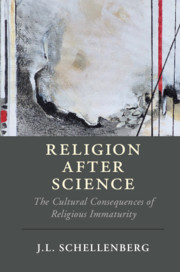Book contents
- Religion After Science
- Cambridge Studies in Religion, Philosophy, and Society
- Religion After Science
- Copyright page
- Dedication
- Contents
- Acknowledgments
- Prologue: The 10,000-Year Test
- 1 Development and the Divine
- 2 The End Is Not Near
- 3 Big Ambitions
- 4 A Poor Record
- 5 Verdict: Immature, Not Doomed
- 6 A New Path for Science and Religion
- 7 The New Agnosticism
- 8 Naturalism Tamed
- 9 Agnostic Religion?
- 10 The New Humanism
- Epilogue: The Religion Project
- Notes
- Index
6 - A New Path for Science and Religion
Published online by Cambridge University Press: 09 August 2019
- Religion After Science
- Cambridge Studies in Religion, Philosophy, and Society
- Religion After Science
- Copyright page
- Dedication
- Contents
- Acknowledgments
- Prologue: The 10,000-Year Test
- 1 Development and the Divine
- 2 The End Is Not Near
- 3 Big Ambitions
- 4 A Poor Record
- 5 Verdict: Immature, Not Doomed
- 6 A New Path for Science and Religion
- 7 The New Agnosticism
- 8 Naturalism Tamed
- 9 Agnostic Religion?
- 10 The New Humanism
- Epilogue: The Religion Project
- Notes
- Index
Summary
In “Atheism, the computer model,” a recent article in Nautilus, Michael Fitzgerald reports on the latest data-driven studies of how societies become supernaturalist, fall away from supernaturalism, and return to it when the going isn’t good. The article concludes with the thoughts of Boston University’s Wesley Wildman, who ventures the view that supernaturalism isn’t likely to disappear, since people have “a basic propensity – a biological imperative – toward a desire to ascribe actions to an agent, a being, even one we cannot see.” As Wildman puts it: “Every generation is born supernaturalists.”
- Type
- Chapter
- Information
- Religion after ScienceThe Cultural Consequences of Religious Immaturity, pp. 66 - 80Publisher: Cambridge University PressPrint publication year: 2019

